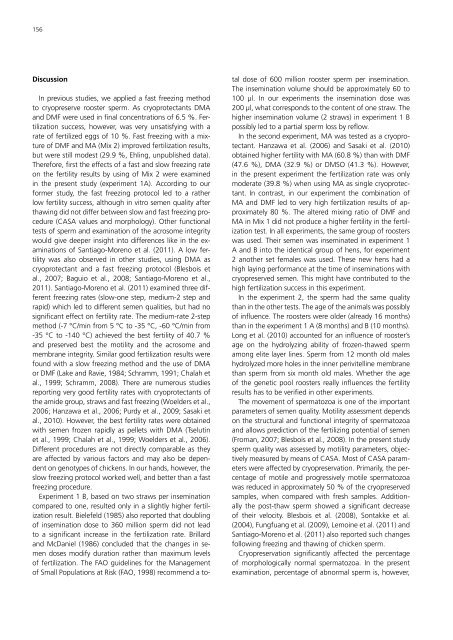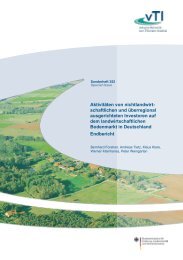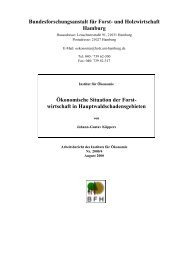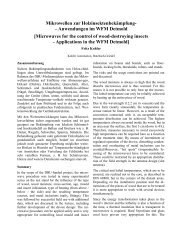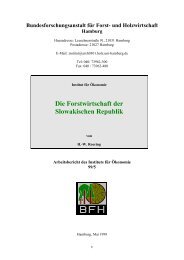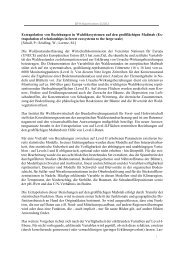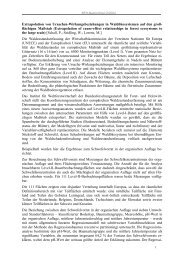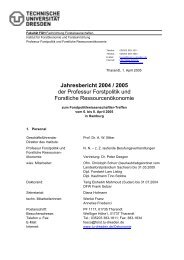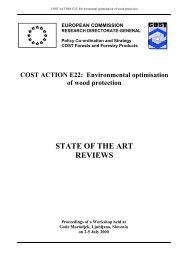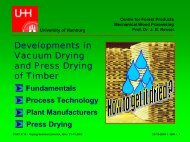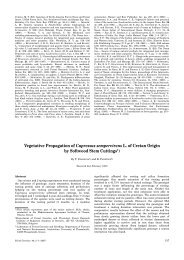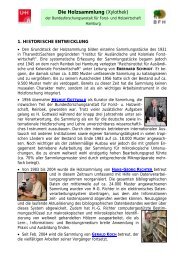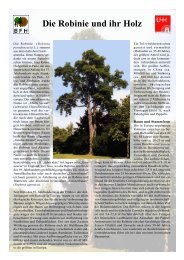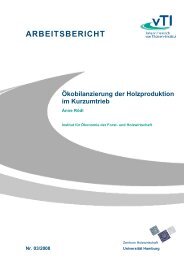Landbauforschung vTI Agriculture and Forestry ... - 1. Januar 2008
Landbauforschung vTI Agriculture and Forestry ... - 1. Januar 2008
Landbauforschung vTI Agriculture and Forestry ... - 1. Januar 2008
Create successful ePaper yourself
Turn your PDF publications into a flip-book with our unique Google optimized e-Paper software.
156<br />
Discussion<br />
In previous studies, we applied a fast freezing method<br />
to cryopreserve rooster sperm. As cryoprotectants DMA<br />
<strong>and</strong> DMF were used in final concentrations of 6.5 %. Fertilization<br />
success, however, was very unsatisfying with a<br />
rate of fertilized eggs of 10 %. Fast freezing with a mixture<br />
of DMF <strong>and</strong> MA (Mix 2) improved fertilization results,<br />
but were still modest (29.9 %, Ehling, unpublished data).<br />
Therefore, first the effects of a fast <strong>and</strong> slow freezing rate<br />
on the fertility results by using of Mix 2 were examined<br />
in the present study (experiment 1A). According to our<br />
former study, the fast freezing protocol led to a rather<br />
low fertility success, although in vitro semen quality after<br />
thawing did not differ between slow <strong>and</strong> fast freezing procedure<br />
(CASA values <strong>and</strong> morphology). Other functional<br />
tests of sperm <strong>and</strong> examination of the acrosome integrity<br />
would give deeper insight into differences like in the examinations<br />
of Santiago-Moreno et al. (2011). A low fertility<br />
was also observed in other studies, using DMA as<br />
cryoprotectant <strong>and</strong> a fast freezing protocol (Blesbois et<br />
al., 2007; Baguio et al., <strong>2008</strong>; Santiago-Moreno et al.,<br />
2011). Santiago-Moreno et al. (2011) examined three different<br />
freezing rates (slow-one step, medium-2 step <strong>and</strong><br />
rapid) which led to different semen qualities, but had no<br />
significant effect on fertility rate. The medium-rate 2-step<br />
method (-7 °C/min from 5 °C to -35 °C, -60 °C/min from<br />
-35 °C to -140 °C) achieved the best fertility of 40.7 %<br />
<strong>and</strong> preserved best the motility <strong>and</strong> the acrosome <strong>and</strong><br />
membrane integrity. Similar good fertilization results were<br />
found with a slow freezing method <strong>and</strong> the use of DMA<br />
or DMF (Lake <strong>and</strong> Ravie, 1984; Schramm, 1991; Chalah et<br />
al., 1999; Schramm, <strong>2008</strong>). There are numerous studies<br />
reporting very good fertility rates with cryoprotectants of<br />
the amide group, straws <strong>and</strong> fast freezing (Woelders et al.,<br />
2006; Hanzawa et al., 2006; Purdy et al., 2009; Sasaki et<br />
al., 2010). However, the best fertility rates were obtained<br />
with semen frozen rapidly as pellets with DMA (Tselutin<br />
et al., 1999; Chalah et al., 1999; Woelders et al., 2006).<br />
Different procedures are not directly comparable as they<br />
are affected by various factors <strong>and</strong> may also be dependent<br />
on genotypes of chickens. In our h<strong>and</strong>s, however, the<br />
slow freezing protocol worked well, <strong>and</strong> better than a fast<br />
freezing procedure.<br />
Experiment 1 B, based on two straws per insemination<br />
compared to one, resulted only in a slightly higher fertilization<br />
result. Bielefeld (1985) also reported that doubling<br />
of insemination dose to 360 million sperm did not lead<br />
to a significant increase in the fertilization rate. Brillard<br />
<strong>and</strong> McDaniel (1986) concluded that the changes in semen<br />
doses modify duration rather than maximum levels<br />
of fertilization. The FAO guidelines for the Management<br />
of Small Populations at Risk (FAO, 1998) recommend a to-<br />
tal dose of 600 million rooster sperm per insemination.<br />
The insemination volume should be approximately 60 to<br />
100 μl. In our experiments the insemination dose was<br />
200 μl, what corresponds to the content of one straw. The<br />
higher insemination volume (2 straws) in experiment 1 B<br />
possibly led to a partial sperm loss by reflow.<br />
In the second experiment, MA was tested as a cryoprotectant.<br />
Hanzawa et al. (2006) <strong>and</strong> Sasaki et al. (2010)<br />
obtained higher fertility with MA (60.8 %) than with DMF<br />
(47.6 %), DMA (32.9 %) or DMSO (4<strong>1.</strong>3 %). However,<br />
in the present experiment the fertilization rate was only<br />
moderate (39.8 %) when using MA as single cryoprotectant.<br />
In contrast, in our experiment the combination of<br />
MA <strong>and</strong> DMF led to very high fertilization results of approximately<br />
80 %. The altered mixing ratio of DMF <strong>and</strong><br />
MA in Mix 1 did not produce a higher fertility in the fertilization<br />
test. In all experiments, the same group of roosters<br />
was used. Their semen was inseminated in experiment 1<br />
A <strong>and</strong> B into the identical group of hens, for experiment<br />
2 another set females was used. These new hens had a<br />
high laying performance at the time of inseminations with<br />
cryopreserved semen. This might have contributed to the<br />
high fertilization success in this experiment.<br />
In the experiment 2, the sperm had the same quality<br />
than in the other tests. The age of the animals was possibly<br />
of influence. The roosters were older (already 16 months)<br />
than in the experiment 1 A (8 months) <strong>and</strong> B (10 months).<br />
Long et al. (2010) accounted for an influence of rooster’s<br />
age on the hydrolyzing ability of frozen-thawed sperm<br />
among elite layer lines. Sperm from 12 month old males<br />
hydrolyzed more holes in the inner perivitelline membrane<br />
than sperm from six month old males. Whether the age<br />
of the genetic pool roosters really influences the fertility<br />
results has to be verified in other experiments.<br />
The movement of spermatozoa is one of the important<br />
parameters of semen quality. Motility assessment depends<br />
on the structural <strong>and</strong> functional integrity of spermatozoa<br />
<strong>and</strong> allows prediction of the fertilizing potential of semen<br />
(Froman, 2007; Blesbois et al., <strong>2008</strong>). In the present study<br />
sperm quality was assessed by motility parameters, objectively<br />
measured by means of CASA. Most of CASA parameters<br />
were affected by cryopreservation. Primarily, the percentage<br />
of motile <strong>and</strong> progressively motile spermatozoa<br />
was reduced in approximately 50 % of the cryopreserved<br />
samples, when compared with fresh samples. Additionally<br />
the post-thaw sperm showed a significant decrease<br />
of their velocity. Blesbois et al. (<strong>2008</strong>), Sontakke et al.<br />
(2004), Fungfuang et al. (2009), Lemoine et al. (2011) <strong>and</strong><br />
Santiago-Moreno et al. (2011) also reported such changes<br />
following freezing <strong>and</strong> thawing of chicken sperm.<br />
Cryopreservation significantly affected the percentage<br />
of morphologically normal spermatozoa. In the present<br />
examination, percentage of abnormal sperm is, however,


